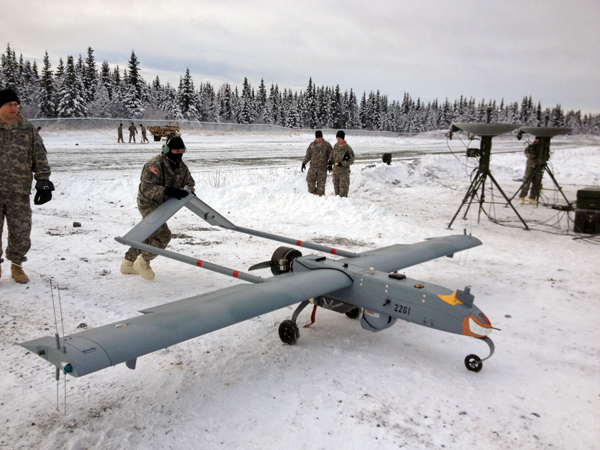
Unmanned Aircraft Systems, or UAS, will soon be flying more often over Joint Base Elmendorf-Richardson.
Soldiers assigned to the aircraft just tested out a new runway on the base earlier this month. Officials say it will allow more training on the remotely piloted aircraft in Anchorage.
According to Chief Warrant Officer Three, Nicholas Jones you’re not likely to see an Unmanned Aircraft or UA flying around, but you might hear it.

“It sounds like a very angry lawn mower,” Jones said.
That’s sound recorded from a UA flight at JBER earlier this month. Jones’s official title is Unmanned Aircraft Systems Operations Officer with the 4th Airborne Brigade, 25th Infantry Division at Joint Base Elmendorf-Richardson.
The unmanned aircraft are like big remote control airplanes, but really, really smart, Jones says. It takes three people on the ground to operate one. The ones flying over JBER lately are called the Shadow. There are four of them at the base. They weigh about 375 pounds, are about 14 feet long with a 14 foot wingspan, with straight wings. The aircraft are unarmed and used for reconnaissance missions, Jones says.
“We just have a few cameras. We’re flying around for operator proficiency,” Jones said. “In combat we do use if for full motion video. In combat one of the catch phrases is ‘eye in the sky’ for the commander.”
In Afghanistan, Jones says the Shadow was used for scouting areas in front of and behind convoys. Recently, the Federal Aviation Administration approved the military’s request to train on the Shadow at JBER and the 27 person platoon assigned to operate the four aircraft tested them out for about 150 hours including landing it on a new runway. The base needed FAA approval because the flight path for takeoff and landing edges out of military air space.
“The way that that runways was built, means that we have to leave that restricted airspace for about 10 seconds on takeoff and landing,” Jones said.
Jones says the new $750,000 runway was needed because other on-base runways are difficult to land on. The new runway insures regular training at JBER into the future.
Jones says, now that the military is scaling back overseas, more and more training is needed at home so soldiers can maintain proficiency.
In Alaska, most of the UAS training used to take place at Donnelly Training Area near Fort Grealy in the town of Delta about two and half hours south of Fairbanks. But Jones says that’s costly, running around $30,000 several times a year. With the new runway at JBER, training will stay in Anchorage and, Jones says, save money over the long run.
Jones says there are lots of misconceptions about what the aircraft do.
“Well, especially here in Alaska, and near big population centers I think the misunderstanding or the tendency is to think that we are out spying on people,” Jones said. “That is not the case. We are simply out doing operator training.”
He also doesn’t like them being referred to as drones. He says that’s an outdated term with negative connotations that the military is trying to shake. He says drone is a word from the early days of the Air Force – they were remote control airplanes that they actually would use as targets and shoot down. And recently, Jones says it’s been used by the media and the public to refer to all remote controlled aircraft used by the military.
“They do refer to them as drones but I think drone has a bad connotation. That’s not what we are doing. We don’t have armament. We are there trying to find people,” Jones said. “We’ve been asked in the past to do search and rescue missions. We’re not flying around dropping bombs on people. So I think drones kind a harsh term for what we do.”
There are also more than a dozen smaller, handheld UA at the base, called Raven. They’re harder to see from the ground than the larger Shadow.
If you live in Eagle River, Jones says, you may catch a glimpse of the aircraft, or at least hear it, but not likely until spring. The Shadow can’t fly in really cold temperatures.
Daysha Eaton is a contributor with the Alaska Public Radio Network.
Daysha Eaton holds a B.A. from Evergreen State College, and a M.A. from the University of Southern California. Daysha got her start in radio at Seattle public radio stations, KPLU and KUOW. Before coming to KBBI, she was the News Director at KYUK in Bethel. She has also worked as the Southcentral Reporter for KSKA in Anchorage.
Daysha's work has appeared on NPR's "Morning Edition" and "All Things Considered", PRI's "The World" and "National Native News". She's happy to take assignments, and to get news tips, which are best sent via email.
Daysha became a journalist because she believes in the power of storytelling. Stories connect us and they help us make sense of our world. They shed light on injustice and they comfort us in troubled times. She got into public broadcasting because it seems to fulfill the intention of the 4th Estate and to most effectively apply the freedom of the press granted to us through the Constitution. She feels that public radio has a special way of moving people emotionally through sound, taking them to remote places, introducing them to people they would not otherwise meet and compelling them to think about issues they might ordinarily overlook.




